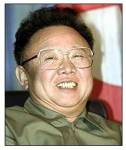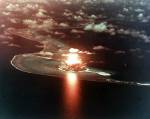http://www.nytimes.com/2009/06/15/world/asia/15kim.html?hp=&pagewanted=print
June 15, 2009
N. Korean Heir Apparent Remains Mystery to West
By CHOE SANG-HUN and MARTIN FACKLER
SEOUL, South Korea â There is only one photograph available outside North Korea thought to be that of the man South Korean officials believe will inherit the worldâs most unpredictable regime, one that is armed with nuclear weapons. In that picture, the man, Kim Jong-un, a son of the ailing North Korean leader, Kim Jong-il, is an 11-year-old.
âWhen Prince Jong-un shook hands with me, he fixed me with a vicious look,â Kim Jong-ilâs former Japanese sushi chef wrote in a 2003 memoir describing his first encounter with the boy, then 7, dressed in a military uniform and known as a âprinceâ among his fatherâs aides. âI still cannot forget the look in his eyes. It seemed to say, âThis is a despicable Japanese.â â
The chef, who goes by the pen name Kenji Fujimoto, said in an interview that as a teenager, Kim Jong-un was already his fatherâs favorite and âlooked just like him.â
The lone photo and Mr. Fujimotoâs memories form part of the few precious strands of information analysts and intelligence officials in South Korea and Washington rely on as they struggle to put together a dossier on Kim Jong-un, the youngest and least-known of Kim Jong-ilâs three sons.
They describe Kim Jong-un as a man in his mid-20s, of medium height, overweight and prone to high blood pressure and suffering from diabetes, and with character traits similar to his fatherâs.
âWe picture a charismatic young man, authoritarian, politically astute and precocious and ambitious,â said Cheong Seong-chang, a researcher at the Sejong Institute, near Seoul. âWe picture Little Kim Jong-il.â
The question of who will succeed Kim Jong-il has grown in importance since he was reported to have suffered a stroke in August. Last week, South Korean news reports, lawmakers and analysts who have access to intelligence assessments said that Mr. Kim, 67, had decided to hand over the reins to Kim Jong-un while North Korean generals, ruling party officials and diplomats abroad were all pledging fealty to the son.
But the walls of secrecy that surround North Korean leaders make the guessing about who is in and who is out in the succession game notoriously difficult. Indeed, the dearth of information about Kim Jong-un speaks volumes about how little the world knows about North Korea itself.
Intelligence officials acknowledge that much of what they have gleaned is little more than conjecture, based on secondhand information from sources inside North Korea but not independently verified.
The North Korean media have never shown images of Kim Jong-un in public or mentioned him by name, said Kim Sang-kook, a senior North Korea analyst at the Unification Ministry in Seoul.
Until Mr. Fujimoto released the photo to the South Korean television network KBS in February, there had been no picture at all of the son. The chef said he was given the picture shortly before he fled to Japan in 2001. Mr. Fujimoto and most analysts say the son was born on Jan. 8, 1983, but others insist that he was born in 1984.
Kim Jong-il apprenticed at important party and military posts for more than 20 years before officially assuming power after the death of his father, Kim Il-sung, in 1994. He appeared with his father in mass gatherings, and his photos decorated the walls of government buildings beside his fatherâs. No such early grooming has been reported for Kim Jong-un.
Now, Kim Jong-ilâs failing health is compelling Mr. Kim to begin a crash program to present his son as the next leader. But installing an untested young man at the top of a belligerent regime where septuagenarian veterans of political machinations jockey for power raises many questions.
âWe know almost nothing about the young man,â said Andrei Lankov, a Russian-born North Korea specialist at Kookmin University in Seoul. âVery young, without any administrative experience to speak of, and without his own coterie â he had not had time to create a power base. He will be an obedient puppet in the hands of people who lobbied for this decision. Who are these people? I have no idea, to be frank.â
The power elite will support another hereditary succession, to keep the peace, some analysts say. But âwhoever the new leader is, it will be a collective leadership in name or actuality,â said Bruce Klingner at the Heritage Foundation, who has worked as a Korea analyst at the Central Intelligence Agency and the Defense Intelligence Agency.
Kim Jong-il had at least five children with three women. Sung Hae-rim, a movie star, gave birth to Kim Jong-nam, now 38. She became estranged from Kim Jong-il after he married Kim Young-sook, who gave birth to one daughter (some say two) but no son.
Then Mr. Kim fell for Ko Young-hee, the prima donna of North Koreaâs premier opera, who was born in Japan and emigrated to the North in the 1960s. She had two sons â Kim Jong-chol, now 28, and Kim Jong-un â and a daughter, Kim Yeo-jong, 22. Until Ms. Ko died of breast cancer in 2004, she was Mr. Kimâs de facto first lady and a fierce campaigner for her sons.
With no mother to promote him to his father, Kim Jong-nam scuttled what remote chance he had of succession when he was caught and deported while sneaking into Japan on a fake passport in 2001. He was headed for Tokyo Disneyland.
The middle son, Kim Jong-chol, attended the International School of Berne in Switzerland in the 1990s under the pseudonym Pak Chol, according to analysts and journalists in Seoul, as well as Mr. Fujimoto â though other analysts dispute these accounts. He was said to be a fan of Michael Jordan, Eric Clapton and Keanu Reeves. Mr. Fujimoto wrote that Ms. Ko often took her sons on trips to Europe and Tokyo Disneyland, and that Kim Jong-un learned English.
Analysts are divided over whether Kim Jong-un also attended the school in Switzerland. They say he was enrolled from 2002 to 2007 in the Kim Il-sung Military University, a leading officer-training school in Pyongyang, the capital, but was taught at home. The son, these accounts say, is about 5 feet 9 inches tall and weighs more than 200 pounds.
Mr. Fujimoto said in an interview that the young man he last saw in 2001 was stocky and athletic but not fat. He said Kim Jong-il dismissed Kim Jong-chol as âgirlishâ but openly complimented Kim Jong-un, saying, âThat boy is like me.â
The sons lived a life few North Koreans could imagine: swimming pools, water fountains, bowling alleys, billiard rooms, inline skating tracks, a beach, Jet Skis and horses.
An episode relayed by Mr. Fujimoto and often cited by analysts to illustrate Kim Jong-unâs sequestered existence, if not his leadership qualities, took place several years ago when the chef and Kim Jong-un were smoking a cigarette in a car. Mr. Kim, then 18, looked into the distance and, according to the chefâs account, said: âWe are here, playing basketball, riding horses, riding Jet Skis, having fun together. But what of the lives of the average people?â
Choe Sang-hun reported from Seoul, and Martin Fackler from Tokyo.
 JB
JB06.14.09 - 7:42 pm
reply
North Korea, albeit all of Korea, was invaded in the late 1800's by Imperial Japan. In 1905 Japan annexed Korea as a colony. Thereby eliminating the nations sovereignty. The United States and other Western nations agreed to recognize Japan's rule over Korea, since they had colonies of their own in Asia (The US had the Philippines, Britain had Hong Kong and Singapore, France had Indochina ie Vietnam, Laos, Cambodia).
Kim Jong il's father, Kim il Sung fled with his parents from Japanese-controlled Korea to Manchuria, China...which was invaded by Imperial Japan in the 1920's. Kim il Sung was 14 years old attending a Chinese school, when he met with other Koreans and wrote about liberating their country. Kim was imprisoned by the Japanese authorities at 15 yrs old. He was released at 16 and fled to the mountainous region of North Korea to join the insurgent rebels fighting the Japanese. The Korean insurgents pleaded with England, France, and the US for help. No one helped them, except Russia.
In the last days of WWII, Russian troops, along with Korean fighters including Kim il Sung, liberated Japanese-controlled Northern Korea. By agreement with the Allies, Russian-backed Korean fighters could not liberate anything south of the 38th parallel. South Korea would be occupied by the US.
Soon after the war, Russian soldiers left North Korea. Leaving the country to WWII hero Kim il Sung to rule. South Korea was ruled by a US appointed American-educated Korean, Sigmund Rhee. Who ended up killing anyone and everyone who opposed him. US soldiers remained in South Korea, putting many of those Koreans who had collaborated with the Japanese in charge of the South Korean government. A slap in the face to Koreans who fought and died fighting the Japanese.
Kim il Sung invaded US-occupied South Korea, in part to free the country of foreigners and punish those who had worked for the Japanese colonial government.
To this day, 38,000 US troops remain on South Korean soil. No foreign troops are stationed in North Korea.
The problems in North Korea are not black and white or good and evil. There is a long and tragic history that most Americans are unaware of. Kim Jong il is not his father, he can never be the WWII hero or the charismatic guerrilla commander. He may not be the best leader, kind of like Bush, but he is their leader until he dies (which will happen in couple of years since he has pancreatic cancer).
We shouldn't be interfering with their right to exist, regardless of whether we like their form of government or not. Imperialism is dead. "Our way or the highway", died with the British and American Empire. We need to find solutions to our differences instead of saying might is right and Western Civilization is superior.
 skd
skd08.4.09 - 3:31 pm
reply
 -->
-->



 We're fucked.
We're fucked.
 North Korea gots you covered
North Korea gots you covered the design of that building is pretty fuckin crazy though
the design of that building is pretty fuckin crazy though